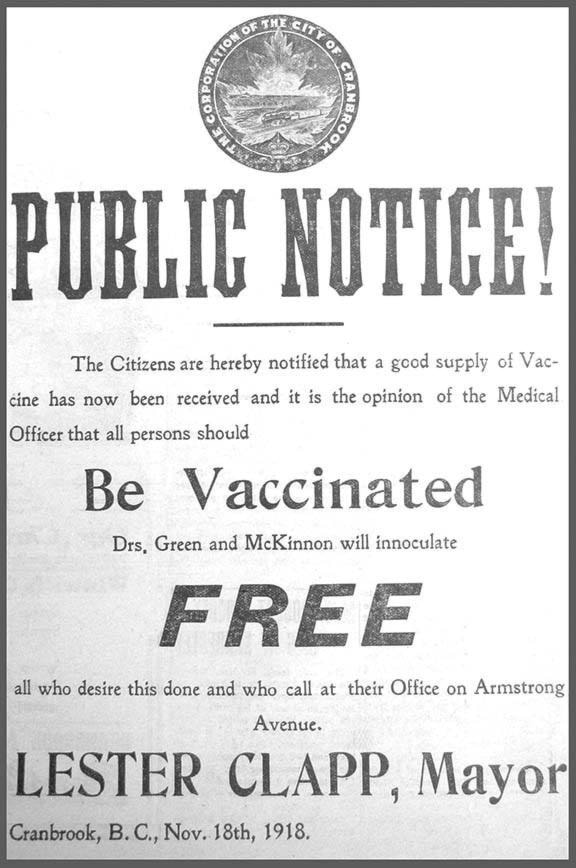Jim Cameron
It appeared to be the best of times rising above the horizon. By the fall of 1918, the war, the "Great War", the "War to End All Wars", was slowly yet inexorably coming to an end; four brutal, bloody years of conflict in Europe, millions dead, rationing, worry and grief, all grinding to a halt. Sadly, the white clouds of hope soon turned a deadly grey.
It was generally referred to as "la grippe" — French for "influenza." It was no stranger to the world in 1918; cough, chills, fever, headache, body ache, fatigue; nothing new there. It was the bane of children, the old and the infirm. Occasional epidemics were noted throughout the centuries but what came before was nothing compared to what arose in those final months of the war.
There is no decisive answer as to where it began although some sources point to a group of soldiers in Kansas, who carried it overseas and who, in turn, were sent to crowded hospitals to recuperate, thus ensuring its rapid transmission. From east to west, continent to continent, from the smallest Pacific islands to the barren wastes of Alaska the disease spread with devastating alacrity. The military did all it could to hush things; bad for morale, no sense worrying people back home. Spain had no such censorship and as the world became aware of the mounting mortalities in the neutral country the disease became known as "Spanish Influenza."
In early October soldiers began dying in Quebec, a few days later in Ontario, then westward to the prairies. By mid-October many cities enacted bans on public gatherings. Churches, schools theatres, arenas, meeting halls and pubs sat empty in vain attempts to curb the onslaught.
By October 24, health restrictions were in force in the Kootenays, a step taken "as a precautionary measure and not because there is any serious outbreak."
Within a week the deaths began, first in Bull River where John McTavish and Art Moran fell victim. There was still hope in Cranbrook that it would pass over but before the end of the month both Walter Riddell and Finlay Robson were taken. These were not the very young or infirm; these were men in good health, in their prime. This was influenza like no other, a disease that fed on youth and vitality.
Halloween was cancelled across the land, the Stanley Cup playoffs suspended mid-series. People wore masks and tried home cures: camphor, glycerin, peppermint, garlic, cinnamon, goose grease, alcohol and tobacco — all proved futile. Drugstores offered remedies which were eagerly sought until local druggist Frank Murphy, age 32, fell ill and died.
People died within days, within hours. Miss Lois Gamble, Mrs. Hope, Mrs. Whiteside, 10-year-old Mildred Wetherell – they all fell in the first week of November. Fourteen-year-old twins John and Jacob Wise, Mary Belle Somerville — the deaths carried on relentlessly.
Mrs. Finlay Robson died one week after her husband, leaving three orphaned children. Her sister came from Calgary to take them back with her and died before she could leave Cranbrook.
The entire town was either sick or nursing those who were. The vacant Wentworth Hotel on Baker Street became a temporary hospital as the bed-ridden were brought in from outlying districts. The Leask residence (quite probably the building still standing on the southwest corner of 2nd Street and 10th Avenue) became a nurse's home for the many volunteers attending the temporary hospital; eight of 10 nurses fell ill.
Mayor Clapp issued a plea for all those capable to help those who were not. Families of seven or eight or more lay abed, unable to care for themselves. Doctors saw up to 80 patients daily while one nurse cared for the same. Single volunteers looked after thirty families at one time.
There is no record of how many died in Cranbrook from the Spanish flu or the pneumonia that often accompanied it. Newspaper accounts and obituaries are incomplete. Indeed, it is surprising that the newspaper continued to publish during the worst of the epidemic, maintaining a positive outlook all the while.
Many deaths — such people as were considered foreigners or second-class citizens — went unrecorded. The deaths may have numbered 50, or 100, or more.
As the second week of November came, the only good news was that the war was finally and truly over. The Armistice was signed November 11 and determined Cranbrookians celebrated that same evening with a parade and a bonfire, the only public gathering during the outbreak.
Vaccinations were offered by mid-November and a great many people took advantage but, in truth, the worst was past. The death count world-wide was nearly beyond comprehension: tens of millions dead. Entire villages wiped out, countless soldiers who survived the fields of Flanders struck down on their return home, the work-force brought to its knees, widows, widowers, orphan upon orphan – it was among the worst pandemics in recorded history.
The local public gathering ban was lifted on midnight December 11, 1918, but people were not quick to congregate. Churches and meetings were poorly attended, movie theatres half empty. In those first weeks of December no one seemed eager to tempt fate.
Gradually, though, as the death count dwindled, things returned to normal. Hockey and curling took to the ice as the weather grew colder. The city band, idle since the early days of the war, struck up once again, the stores filled with Christmas shoppers and church pews filled.
The New Year was heartily welcomed during the annual dance at the Auditorium and the town, the country, the world moved on.
